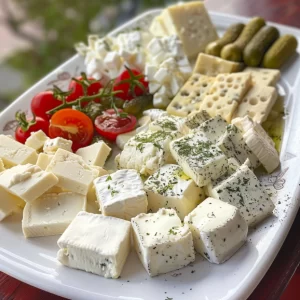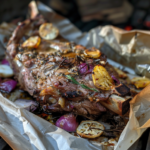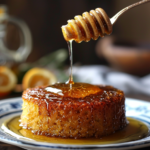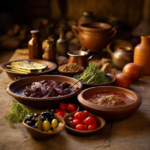
If you’re a cheese lover, then get ready to embark on a taste bud adventure through the rich and flavorful world of Greek cheeses. From the famous Feta cheese to lesser-known varieties like Kasseri and Graviera, Greek cheeses offer a diverse range of textures and tastes that are sure to satisfy any palate. Dive into the Greek culinary heritage and explore the dairy traditions that have been passed down through generations.
Discover Greek cheese recipes and learn about the perfect pairings for these Mediterranean dairy products. Whether you’re indulging in a Greek cheese platter or enjoying the distinct flavor of aged Greek cheeses, there’s no doubt that the cheese-making tradition in Greece is truly something to savor. So grab a slice, crumble some Feta, and let your taste buds be transported to the sun-kissed shores of Greece.
Greek Cheeses: Exploring the Variety of Cheese in Greece
If you’re a cheese lover, then you’re in for a treat when it comes to Greek cheeses. Greece is known for its rich culinary heritage and the diversity of its cheeses is no exception. From the famous Feta cheese to lesser-known varieties like Kasseri and Metsovone, Greek cheeses offer a wide range of flavors, textures, and tastes to satisfy any cheese connoisseur.
1. Greek Cheese Varieties
1.1 Feta Cheese
Let’s start with the one that most people are familiar with – Feta cheese. This is undoubtedly the most famous Greek cheese, known for its crumbly texture and tangy taste. Feta cheese is traditionally made from sheep’s milk or a mixture of sheep’s and goat’s milk, giving it a unique flavor profile. It is a versatile cheese that can be used in salads, pastries, and many other dishes.
1.2 Kasseri Cheese
Another popular Greek cheese is Kasseri, which is a semi-hard cheese made from sheep’s milk. It has a slightly elastic texture and a rich, buttery flavor. Kasseri cheese is often used in Greek cuisine for its distinct flavor and grating properties. It’s perfect for melting in dishes like saganaki or for adding a burst of flavor to sandwiches and wraps.
1.3 Graviera Cheese
Graviera Cheese: Unlocking the Essence of Crete’s Culinary Treasure
Graviera is a hard cheese that is typically made from sheep or goat milk, or a combination of the two. It has a smooth texture and a sweet, nutty flavor that becomes more pronounced as it ages. Graviera is often grated or melted and used in dishes like moussaka or pastitsio, but it can also be enjoyed on its own as part of a cheese platter.
1.4 Kefalotyri Cheese
Unleash the Bold Flavors of Kefalotyri Cheese: A Culinary Revelation
Kefalotyri is another hard, salty cheese that is commonly used in Greek cuisine. It is made from sheep’s or goat’s milk and has a strong, sharp flavor. Kefalotyri is often grated and sprinkled over pasta dishes or used in cheese pies and stuffed vegetables. Its distinctive taste adds depth and richness to any dish.
1.5 Mizithra Cheese
Mizithra is a fresh cheese that is made from sheep’s or goat’s milk, or a combination of the two. It has a soft, crumbly texture and a mild, slightly tangy flavor. Mizithra cheese is often used in both sweet and savory dishes in Greek cuisine. It can be sprinkled over salads, used as a filling for pastries, or eaten on its own with a drizzle of honey.
1.6 Ladotyri Cheese
Ladotyri is a specialty cheese from the island of Lesvos that is made from sheep’s milk. It is aged in olive oil, giving it a rich, savory flavor and a slightly firm texture. The olive oil imparts a distinct aroma to the cheese, making it a unique and flavorful addition to any cheese platter or salad.
1.7 Anthotyros Cheese
Delicate Delicious Flavors of Anthotyros Cheese: A Greek Culinary Journey
Anthotyros is a fresh cheese that is made from sheep’s or goat’s milk. It has a creamy texture and a mild, slightly sweet flavor. Anthotyros cheese is often used in traditional Greek desserts like bougatsa or galaktoboureko, where its delicate taste and creamy consistency complement the sweetness of the dessert.
1.8 Manouri Cheese
Manouri is a semi-soft cheese that is made from the whey left over from the production of feta cheese. It has a creamy texture and a slightly tangy, milky flavor. Manouri cheese is a versatile option that can be used in both sweet and savory dishes. It can be served as a dessert with honey and nuts, or used as a filling for pastries or in salads.
1.9 Kopanisti Cheese
Bold Flavors of Kopanisti Cheese: A Greek Culinary Adventure
Kopanisti is a spicy cheese that is made from sheep’s milk. It has a creamy texture and a bold, peppery flavor. Kopanisti cheese is traditionally made on the island of Mykonos and is often used as a spread or dip. Its intense flavor and creamy consistency make it a perfect accompaniment to bread or crackers.
1.10 Metsovone Cheese
Bold Flavors of Metsovone Cheese: A Greek Culinary Revelation
Metsovone is a smoked cheese that has a firm texture and a rich, smoky flavor. It is made from cow’s milk and is often compared to smoked Gouda or Provolone. Metsovone cheese is delicious on its own or melted on sandwiches or burgers. Its smoky taste adds a unique dimension to any dish.
Halloumi Cheese Exploring the Delightful World of Greek Cheeses
2. Greek Cheese Production
2.1 Dairy traditions in Greece
Greek cheese production dates back centuries, with the country’s dairy traditions deeply rooted in its culture and history. The rearing of sheep and goats for milk has long been a common practice in Greece, with many households having their own small herds. This tradition has been passed down through generations and plays a significant role in the production of high-quality Greek cheeses.
2.2 Greek culinary heritage
Greek cuisine is renowned for its use of fresh, high-quality ingredients, and cheese is no exception. The cheeses produced in Greece are often made with milk from animals that graze on open pastures, resulting in flavors that reflect the country’s varied landscapes. The rich culinary heritage of Greece is showcased in the diverse range of cheeses, each with its own unique taste and texture.
2.3 Cheese production techniques in Greece
Traditional cheese-making techniques are still widely used in Greece today, ensuring that the cheeses retain their authentic flavors and characteristics. The milk is typically curdled using natural methods, such as the addition of rennet or allowing the milk to sour naturally. The curds are then drained and aged to develop their distinct flavors and textures.
2.4 Traditional cheese-making in Greece
Cheese-making in Greece is often a family affair, with recipes and techniques passed down from generation to generation. Small, artisanal producers play a vital role in preserving traditional cheese-making methods and ensuring the continued production of high-quality Greek cheeses. These traditional methods are what give Greek cheeses their unique flavor profiles and contribute to their overall excellence.
2.5 Greek dairy farms
Dairy farms in Greece are often small-scale operations, with animals typically raised on family-owned land. This allows for close oversight of the animals’ nutrition and health, resulting in milk of exceptional quality. The emphasis on sustainable and ethical farming practices ensures the welfare of the animals and the production of high-quality milk, which is essential for the production of Greek cheeses.
3. Greek Cheese in Greek Cuisine
3.1 Traditional Greek dairy recipes
Greek cuisine boasts a wide variety of traditional recipes that incorporate cheese in various ways. Spanakopita, for example, is a classic Greek dish made with layers of phyllo pastry, spinach, and feta cheese. Baklava, a popular dessert, features layers of phyllo pastry filled with a mixture of nuts and honey. These are just a few examples of the many delicious dishes that highlight the versatility of Greek cheeses.
3.2 Greek cheese pairings
Greek cheeses pair well with a variety of ingredients and flavors, making them versatile additions to any meal. Feta cheese, for instance, pairs beautifully with fresh vegetables, olives, and olive oil. Graviera cheese complements fruits, nuts, and honey, creating a delightful combination of sweet and savory flavors. Experimenting with different pairings can lead to exciting and unexpected taste experiences.
3.3 Greek cheese tastings
Greek cheese tastings are a fantastic way to explore the diversity of flavors that Greek cheeses have to offer. By sampling a range of cheeses, you can appreciate the nuances in texture, taste, and aroma that make each variety unique. Many specialty cheese shops and restaurants offer cheese tastings, allowing you to discover your favorites and expand your palate.
3.4 Greek cheese platter
A Greek cheese platter is a beautiful and delicious way to showcase the variety of Greek cheeses. Arrange a selection of cheeses, such as Feta, Kasseri, and Graviera, on a platter along with olives, fresh fruits, and crusty bread. This creates an enticing spread that can be enjoyed as an appetizer or as the centerpiece of a Mediterranean-inspired gathering.
3.5 Gourmet Greek cheeses
If you’re looking for an elevated dining experience, gourmet Greek cheeses are sure to impress. These high-quality artisanal cheeses often come from small producers who use traditional methods and carefully select their ingredients. Gourmet Greek cheeses, such as aged Kefalotyri or handmade Manouri, offer exceptional flavors and textures that will elevate any meal to a gourmet level.
4. Texture and Taste of Greek Cheese
4.1 Aged Greek cheeses
Aged Greek cheeses develop complex flavors and textures as they mature. The aging process allows the flavors to deepen and intensify, resulting in cheeses that are rich, robust, and full-bodied. Cheeses like Graviera and Kefalotyri age beautifully and become more flavorful over time.
4.2 Greek cheese texture
Greek cheeses exhibit a wide range of textures, from crumbly and creamy to hard and elastic. The texture of a cheese can greatly impact its taste and the way it interacts with other ingredients in a dish. Whether you prefer a soft and creamy Mizithra cheese or a firm and chewy Kasseri cheese, there is a Greek cheese to suit every texture preference.
4.3 Greek cheese taste
Greek cheeses are known for their distinctive flavors, which are influenced by various factors such as the type of milk used, the aging process, and the region of production. From the tangy and salty taste of Feta to the nutty and sweet flavors of Graviera, each cheese has its own unique taste that reflects the diversity of Greek culinary heritage.
5. Nutritional Facts about Greek Cheese
5.1 Greek cheese nutritional values
Greek cheeses are not only delicious but also offer several nutritional benefits. They are a good source of protein, calcium, and vitamin D, which are essential for bone health. Greek cheeses are also rich in vitamins and minerals, such as vitamin B12, zinc, and phosphorus, which are important for overall health and well-being.
5.2 Health benefits of Greek cheese
In addition to their nutritional value, Greek cheeses are also associated with various health benefits. The consumption of moderate amounts of cheese has been linked to a reduced risk of osteoporosis, heart disease, and certain types of cancer.
Greek cheeses, with their high-quality ingredients and traditional production methods, offer a healthy and flavorful addition to a balanced diet.
In conclusion, Greek cheeses offer a delightful exploration of flavors, textures, and tastes. From the famous Feta cheese to lesser-known varieties like Kasseri and Metsovone, Greek cheeses are a true treasure trove for cheese lovers.
Whether enjoyed on their own, paired with other ingredients, or incorporated into traditional Greek recipes, Greek cheeses are sure to tantalize your taste buds and transport you to the sun-drenched shores of Greece. So go ahead, indulge in the richness and variety of Greek cheeses and embark on a culinary adventure like no other.
Celebrity Chefs on Chef on a Bike YouTube
Greek TV Chef Anna-Maria Barouh
- Facebook: Anna-Maria Barouh
- Instagram: annamariabarouh
- Celebrity Chef, Food Stylist, Recipe Developer Anna Maria Barouh is our guest on Chef on a Bike. Anna-Maria is a regular on Greek Television and has a very popular food blog and is a magazine contributor.
- YouTube Episode: Chef on a Bike YouTube Episode
Cyprus’ Culinary Ambassador – Marilena Joannides
- Cyprus’ Culinary Ambassador – Marilena Joannides shows us how to make Easter Bread typical of Karpasia Cyprus. Marilena Joannides is a Culinary Expert known for her extensive research and knowledge in Mediterranean Cuisine. She is also the author of Cyprus Food Treasures. YouTube Episode: Chef on a Bike Episode
Grill Philosophy Greek Recipes and Grilling
- YouTube Channel: Grill Philosophy Explore traditional Greek recipes and grilling techniques with Grill Philosophy on Chef on a Bike.


















